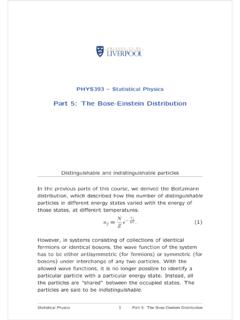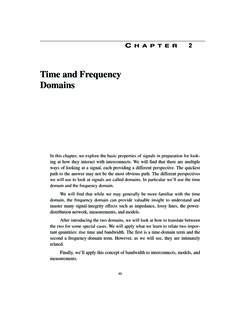Transcription of Hermite and Laguerre Polynomials
1 Chapter 13 Hermite and LaguerrePolynomialsIn this chapter we study two sets of orthogonal Polynomials , Hermite andLaguerre Polynomials . These sets are less common in mathematical physicsthan the Legendre and Bessel functions of Chapters 11 and 12, but Hermitepolynomials occur in solutions of the simple harmonic oscillator of quantummechanics and Laguerre Polynomials in wave functions of the hydrogen the general mathematical techniques are similar to those of thepreceding two chapters, the development of these functions is only detailed proofs, along the lines of Chapters 11 and 12, are left to thereader. We start with Hermite Hermite PolynomialsQuantum Mechanical Simple Harmonic OscillatorFor the physicist, Hermite Polynomials are synonymous with the one-dimensional ( , simple) harmonic oscillator of quantum mechanics. For apotential energyV=12Kz2=12m 2z2,forceFz= V/ z= Kz,the Schr odinger equation of the quantum mechanical system is h22md2dz2 (z)+12Kz2 (z)=E (z).
2 ( )Our oscillating particle has massmand total energyE. From quantum me-chanics, we recall that for bound states the boundary conditionslimz (z)=0( ) Polynomials639restrict the energy eigenvalueEto a discrete setEn= n h , where is theangular frequency of the corresponding classical oscillator. It is introducedby rescaling the coordinatezin favor of the dimensionless variablexandtransforming the parameters as follows:x= zwith 4 mK h2 m2 2 h2,2 n 2En h mK 1/2=2En h .( )Eq.( ) becomes [with (z)= (x/ )= (x)] the ordinary differentialequation (ODE)d2 n(x)dx2+(2 n x2) n(x)=0.( )If we substitute n(x)=e x2/2Hn(x) into Eq. ( ), we obtain the ODEH n 2xH n+(2 n 1)Hn=0( )of Exercise A power series solution of Eq. ( ) shows thatHn(x) willbehave asex2for largex, unless n=n+1/2,n=0, 1, 2,..Thus, n(x) and n(z) will blow up at infinity, and it will be impossible for the wave function (z) to satisfy the boundary conditions [Eq. ( )] unlessEn= n h = n+12 h ,n=0, 1, ( )This is the key property of the harmonic oscillator spectrum.
3 We see that theenergy is quantized and that there is a minimum or zero point energyEmin=E0=12 h .This zero point energy is an aspect of the uncertainty principle, a genuinequantum phenomenon. Also, with 2 n 1=2n, Eq. ( ) becomes Hermite sODE andHn(x) are the Hermite Polynomials . The solutions n(Fig. ) ofEq. ( ) are proportional to the Hermite polynomials1Hn(x).This is the differential equations approach, a standard quantum mechani-cal treatment. However, we shall prove these statements next employing themethod of ladder and Lowering OperatorsThe following development is analogous to the use of the raising and loweringoperators for angular momentum operators presented in Section The keyaspect of Eq. ( ) is that its Hamiltonian 2H d2dx2 x2= ddx x ddx+x + x,ddx ( )1 Note the absence of a superscript, which distinguishes Hermite Polynomials from the unrelatedHankel functions in Chapter 13 Hermite and Laguerre (x) (x)Figure WaveFunctions. TheHeavy Bar on thex-Axis Indicates theAllowed Range ofthe ClassicalOscillator with theSame Total Energyalmost factorizes.
4 Using naivelya2 b2=(a b)(a+b), the basic commutator[px,x]= h/iof quantum mechanics [with momentumpx=( h/i)d/dx] entersas a correction in Eq. ( ). [Becausepxis Hermitian,d/dxis anti-Hermitian,(d/dx) = d/dx.] This commutator can be evaluated as follows. Imaginethe differential operatord/dxacts on a wave function (x) to the right, as inEq. ( ), so thatddx(x )=xddx + ( )by the product rule. Dropping the wave function from Eq. ( ), we rewriteEq. ( ) asddxx xddx ddx,x =1,( )a constant, and then verify Eq. ( ) directly by expanding the product. Theproduct form of Eq. ( ), up to the constant commutator, suggests introduc-ing the non-Hermitian operators a 1 2 x ddx , a 1 2 x+ddx ,( )with ( a) = a .They obey the commutation relations[ a, a ]= ddx,x =1,[ a, a]=0=[ a , a ],( ) Polynomials641which are characteristic of these operators and straightforward to derivefrom Eq. ( ) and[d/dx,d/dx]=0=[x,x]and [x,d/dx]= [d/dx,x].Returning to Eq. ( ) and using Eq. ( ), we rewrite the Hamiltonian asH= a a+12= a a+12[ a, a ]=12( a a+ a a )( )and introduce the Hermitiannumber operatorN= a aso thatH=N+1 also use the simpler notation n=|n so that Eq.
5 ( ) becomesH|n = n|n .Now we prove the key property thatNhas nonnegative integer eigenvaluesN|n = n 12 |n =n|n ,n=0, 1, 2,..,( )that is, n=n+1 | a|n |2= n| a a|n = n 12 0,( )we see thatNhas nonnegative now show that the commutation relations[N, a ]= a ,[N, a]= a,( )which follow from Eq. ( ), characterizeNas the number operator thatcounts the oscillator quanta in the eigenstate|n .To this end, we determinethe eigenvalue ofNfor the states a |n and a|n .Using a a =N+1, we seethatN( a |n )= a (N+1)|n = n+12 a |n =(n+1) a |n ,( )N( a|n )=( a a 1) a|n = a(N 1)|n = n 12 a|n =(n 1) a|n .In other words,Nacting on a |n shows that a has raised the eigenvaluenof|n by one unit; hence its nameraising or creation operator. Applying a repeatedly, we can reach all higher excitations. There is no upper limit tothe sequence of eigenvalues. Similarly, alowers the eigenvaluenby one unit;hence, it is alowering or annihilation operator. Therefore, a |n |n+1 , a|n |n 1 .( )Applying arepeatedly, we can reach the lowest or ground state|0 with eigen-value cannot step lower because 0 1 , a|0 0,642 Chapter 13 Hermite and Laguerre Polynomialssuggesting we construct 0=|0 from the (factored)first-orderODE 2 a 0= ddx+x 0=0.
6 ( )Integrating 0 0= x,( )we obtainln 0= 12x2+lnc0,( )wherec0is an integration constant. The solution 0(x)=c0e x2/2( )can be normalized, withc0= 1/4using the error integral. Substituting 0into Eq. ( ) wefindH|0 = a a+12 |0 =12|0 ( )so that its energy eigenvalue is 0=1/2 and its number eigenvalue isn=0,confirming the notation|0 .Applying a repeatedly to 0=|0 , all other eigen-values are confirmed to be n=n+1/2, proving Eq. ( ). The normaliza-tions in Eq. ( ) follow from Eqs. ( ), ( ), and| a |n |2= n| a a |n = n| a a+1|n =n+1,( )showing n+1|n+1 = a |n , n|n 1 = a|n .( )Thus, the excited-state wave functions, 1, 2, and so on, are generated by theraising operator|1 = a |0 =1 2 x ddx 0(x)=x 2 1/4e x2/2,( )yielding [and leading to Eq. ( )] n(x)=NnHn(x)e x2/2,Nn= 1/4(2nn!) 1/2,( )whereHnare the Hermite Polynomials (Fig. ).Biographical DataHermite, , a French mathematician, was born in Dieuzein 1822 and died in Paris in 1902. His most famous result is thefirst proof thateis a transcendental number; that is,eis not the root of any polynomial withinteger coefficients.
7 He also contributed to elliptic and modular been recognized slowly, he became a professor at the Sorbonne Polynomials643x1086420 2H2(x)H1(x)H0(x)12 Figure PolynomialsRecurrence Relations and Generating FunctionNow we can establish the recurrence relations2xHn(x) H n(x)=Hn+1(x),H n(x)=2nHn 1(x),( )from whichHn+1(x)=2xHn(x) 2nHn 1(x)( )follows by adding them. To prove Eq. ( ), we applyx ddx= ex2/2ddxe x2/2( )to n(x) of Eq. ( ) and recall Eq. ( ) tofindNn+1Hn+1e x2/2= Nn 2(n+1)e x2/2( 2xHn+H n),( )that is, thefirst part of Eq. ( ). Usingx+d/dxinstead, we get the secondhalf of Eq. ( ).EXAMPLE First Few Hermite PolynomialsWe expect thefirst Hermite polyno-mial to be a constant,H0(x)=1, being normalized. Thenn=0 in the recursionrelation [Eq. ( )] yieldsH1=2xH0=2x;n=1 impliesH2=2xH1 2H0=4x2 2, andn=2 impliesH3(x)=2xH2(x) 4H1(x)=2x(4x2 2) 8x=8x3 with Eq. ( ) forn=0, 1, 2, we verify that our results areconsistent: 2xH0 H 0=H1=2x 1 0, etc. For convenient reference, thefirst several Hermite Polynomials are listed in Table 644 Chapter 13 Hermite and Laguerre PolynomialsTable PolynomialsH0(x)=1H1(x)=2xH2(x)=4x2 2H3(x)=8x3 12xH4(x)=16x4 48x2+12H5(x)=32x5 160x3+120xH6(x)=64x6 480x4+720x2 120 The Hermite polynomialsHn(x) may be summed to yield thegeneratingfunctiong(x,t)=e t2+2tx= n=0Hn(x)tnn!
8 ,( )which we derive next from the recursion relation [Eq. ( )]:0 n=1tnn!(Hn+1 2xHn+2nHn 1)= g t 2xg+2tg.( )Integrating this ODE intby separating the variablestandg,weget1g g t=2(x t),( )which yieldslng=2xt t2+lnc,g(x,t)=e t2+2xtc(x),( )wherecis an integration constant that may depend on the parameterx. Directexpansion of the exponential in Eq. ( ) givesH0(x)=1 andH1(x)=2xalong withc(x) ValuesSpecial values of the Hermite Polynomials follow from thegenerating function forx=0; that is,g(x=0,t)=e t2= n=0Hn(0)tnn!= n=0( 1)nt2nn!.A comparison of coefficients of these power series yieldsH2n(0)=( 1)n(2n)!n!,H2n+1(0)=0.( ) EXAMPLE , we obtain from the generating function identityg( x,t)=e t2 2tx=g(x, t)( )the power series identity n=0Hn( x)tnn!= n=0Hn(x)( t)nn!, Polynomials645which implies the importantparity relationHn(x)=( 1)nHn( x).( ) In quantum mechanical problems, particularly in molecular spectrosopy, anumber of integrals of the form xre x2Hn(x)Hm(x)dxare needed. Examples forr=1 andr=2 (withn=m) are included in the ex-ercises at the end of this section.
9 Many other examples are contained in Wilsonet oscillator potential has also been employed extensively in calcula-tions of nuclear structure (nuclear shell model) and quark models of is a second independent solution to Eq. ( ). This Hermite functionis an infinite series (Sections and ) and of no physical interest RepresentationsDifferentiation of the generating function3ntimes with respect totand thensettingtequal to zero yieldsHn(x)=( 1)nex2dndxne x2.( )This gives us a Rodrigues representation ofHn(x). A second representationmay be obtained by using the calculus of residues (Chapter 7). If we multiplyEq. ( ) byt m 1and integrate around the origin, only the term withHm(x)will survive:Hm(x)=m!2 i t m 1e t2+2txdt.( )Also, from Eq. ( ) we may write our Hermite polynomialHn(x) in seriesform:Hn(x)=(2x)n 2n!(n 2)!2!(2x)n 2+4n!(n 4)!4!(2x)n 41 3 =[n/2] s=0( 2)s(2x)n 2s n2s 1 3 5 (2s 1)=[n/2] s=0( 1)s(2x)n 2sn!(n 2s)!s!.( )This series terminates for integralnand yields our Hermite , E.
10 B., Jr., Decius, J. C., and Cross, P. C. (1955).Molecular Vibrations. McGraw-Hill,New York. Reprinted, Dover, New York (1980).3 Rewrite the generating function asg(x,t)=ex2e (t x)2. Note that te (t x)2= xe (t x) 13 Hermite and Laguerre PolynomialsEXAMPLE Lowest Hermite PolynomialsForn=0, wefind from the series,Eq. ( ),H0(x)=( 1)0(2x)00!0!0!=1;forn=1,H1(x)=( 1)0(2x)11!1!0!=2x; and forn=2, thes=0 ands=1 terms in Eq. ( ) giveH2(x)=( 1)0(2x)22!2!0! (2x)02!0!1!=4x2 2,etc. OrthogonalityThe recurrence relations [Eqs. ( ) and ( )] lead to the second-orderODEH n(x) 2xH n(x)+2nHn(x)=0,( )which is put Eq. ( ) in self-adjoint form, we multiply by exp( x2) ( ). This leads to the orthogonality integral Hm(x)Hn(x)e x2dx=0,m =n,( )with the weighting function exp( x2) a consequence of putting the differen-tial equation into self-adjoint form. The interval ( , ) is dictated by theboundary conditions of the harmonic oscillator, which are consistent with theHermitian operator boundary conditions (Section ).


